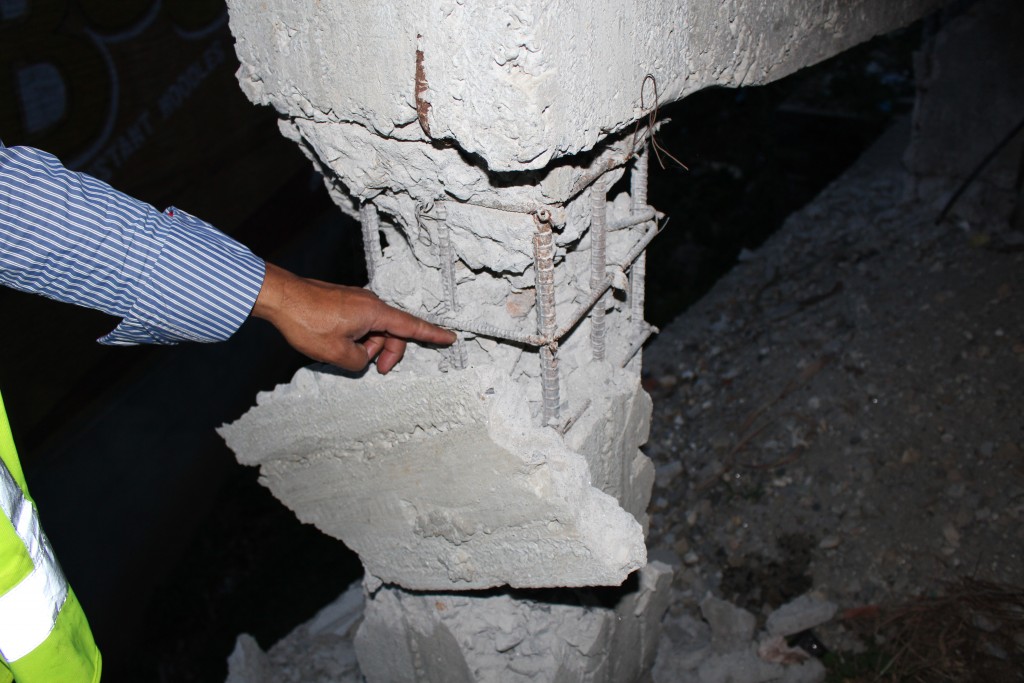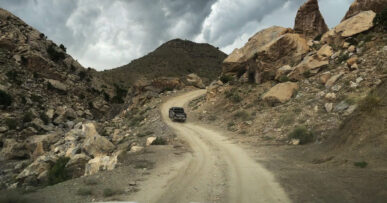- Nepal Earthquake: Fearful Tourists Sleeping Outside
- Nepal Earthquake: What Happened in the Kathmandu Disaster?
- Godawari: Damage Assessment of an Orphanage, and Tea
- Nepal Earthquake: Burning Roadblocks, Flattened Schools and Everest
- One Way Ticket: Haiti, New York, Dubai, Kathmandu, Nepal
KATHMANDU, Nepal–We are driving fast through burning roadblocks. People are upset and demonstrating. Food and water has not reached this remote part of country yet. It is one of the least developed districts in Nepal. When one of the roadblocks forces us to stop, one of protesters approaches me to apologize. “I am so sorry to stop the traffic. But we are making a statement to the government. We need food, water and tents as soon as possible.” Then he invited me to his camp, to share his “meager dinner.” This is probably the most respectable protester I have ever met.
This area is about three hours of riding on rocky mountain roads from Kathmandu. It is almost 100km from the original epicenter and was totally destroyed by the magnitude-6.5 aftershocks. We enter a city with a proper main road commercial district with two- and three-story buildings. My guess is that 80 percent of these brick buildings are flattened or about to collapse. But I found one newer concrete structure standing. The columns of this building are heavily deformed, but it still has the structural capacity to carry the weight. And then I see it… good rebar detailing. It is something you would find in modern buildings in California or Tokyo. It is amazing to see that such good practices exist in the middle of these mountains. Impressive.

We drive up to the school grounds. We were asked by Nepal’s Minister of Education to examine some of the schools in remote areas. It is a horrible find. What was just recently a large, three-story school is now a just rubble of brick, concrete and broken desks.
I find that all of the columns are made of bricks without any reinforcement. This is something I found in Sichuan China back in 2008. It killed tens of thousands of school children. Nepal was luckier. The earthquake happened in the middle of a weekend when no schools were in session. It was a Saturday and people were out in the fields. If this happened in the middle of night or on a school day, it would have killed tens of thousands or more people. As it was, unreinforced masonry destruction in countryside is complete.
Still, everyone needs help – and soon. Monsoon season is a few weeks away. The way I understand it, it’s like having Category 3 hurricanes for two months solid. They need shelter fast, but there is almost no international support.
Today on the 10th of May, Marco Cossu from the Italy office, Sabine Kast from Miyamoto Relief and Brian Planas from California joined me. They all worked with me after the earthquake in Haiti, so it’s nice to see old faces and colleagues who’ve worked together in the past. We will make a good team here.
On the 21st of May the aftershocks keep rumbling. Today I’m meeting with the directors of Nepal’s tourism ministry, who want to know how they can ensure safe trekking in the Himalayas. The earthquake killed more than 50 trekkers and they say that 100 remain missing. Many were killed by rock slides caused by the earthquake. This is a big deal here in Nepal, since 25 percent of Nepal’s GDP comes from tourism. They ask us, “Are you good enough to trek up to the Everest base camp to see the damage, the conditions of trails, the suspension bridges and mountain huts?”
Well, how can I say no to such a request? We will collaborate with the association of trekking companies and guides to plan this adventure and important work. The task is critical for recovery of tourism and eventually the economic health of Nepal. Our tagline is “save lives, impact economies.” This is exactly the kind of thing we help countries throughout the world do.
 As soon as, I finish the ministry meeting, my driver and I head off to the next meeting in his small, beat up Toyota with the permanently broken side window. The next stop is the Golden high-rise condominium complex, where many residents are waiting for me. Here in Kathmandu, many high rise buildings are damaged. Long period motion caused by the soft, ancient lake bed under this city resonance these tall structures.
As soon as, I finish the ministry meeting, my driver and I head off to the next meeting in his small, beat up Toyota with the permanently broken side window. The next stop is the Golden high-rise condominium complex, where many residents are waiting for me. Here in Kathmandu, many high rise buildings are damaged. Long period motion caused by the soft, ancient lake bed under this city resonance these tall structures.
About 50 residents representing the complex wait patiently. When I arrive, the mood is hostile and dark. I don’t blame them. It’s a brand new building, which they just recently paid for and moved in. Almost all of the walls are cracked and broken on the bottom half of the wall. It is very dangerous.
I explain why the walls cracked and what we should do to fix them. After several dozen questions and answers, I feel the mood of crowd begin to change. It is critical to be open and transparent in conditions like this. I feel they are trusting us and counting on us. Their investment and lives are at stake. Our responsibility is heavy, but this is why I do what I do. We can make a difference. Lives can be saved.




